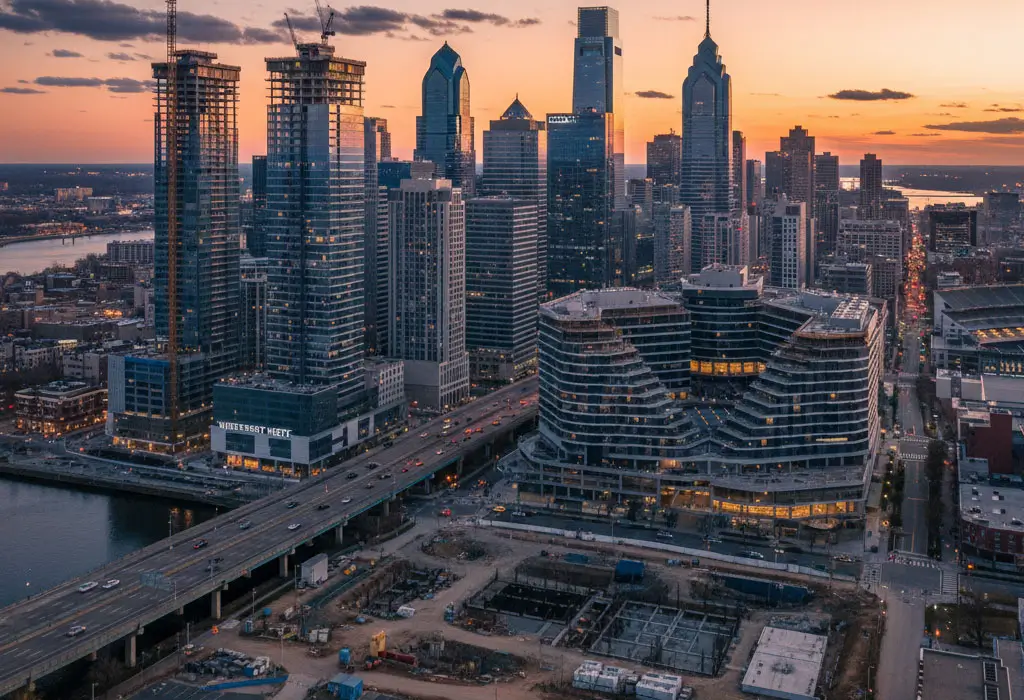Philadelphia development projects in 2025 mark a vibrant era of urban transformation. The city buzzes with initiatives that blend modern architecture, sustainable practices, and community needs. From impressive residential skyscrapers to major infrastructure upgrades, these initiatives strive to enhance economic growth while tackling housing shortages. As federal funding flows in, developers focus on creating inclusive spaces that honor Philly’s history. This guide highlights key projects reshaping the skyline and fostering growth for residents and businesses alike.

The Center City Boom: Urban Towers and Real Estate Development
Center City pulses with energy as new towers rise. These developments cater to a growing population seeking urban living. Mixed-use buildings combine homes, offices, and retail, creating lively hubs. Investments exceed $1.2 billion, signaling strong confidence in Philly’s future.
Spotlight on the New Philadelphia Arena Project
The 76 Place arena stands out among Philadelphia development projects in 2025. This $1.3 billion venue, proposed by the Philadelphia 76ers, targets Center City. It promises 18,500 seats and an opening by the 2031 NBA season. Yet, construction timelines stretch into 2025 for planning and approvals.
Key features include state-of-the-art facilities for sports and events. Concerns are growing in Chinatown, particularly about traffic and increasing rents.. Developers pledge jobs and economic boosts, aiming to attract millions of visitors yearly. This project could redefine downtown entertainment.
Key Residential and Commercial Towers Under Construction
Residential towers dominate the boom. For example, Chubb’s new 18-story headquarters will provide additional office space, even though it won’t open until 2025. In Center City West, an office tower, life sciences building, and apartment complex near the Schuylkill River near completion. These add thousands of units, easing housing pressures.
Commercial projects like uCity Square and Schuylkill Yards expand lab and office spaces. With 66 projects underway or planned, Center City sees continued growth from Girard Avenue to Tasker Street. The impacts include increased property values and lively streets, although affordability continues to be a concern.
Driving Forward: Major Concrete Infrastructure Investments
Infrastructure forms the backbone of Philly’s progress. Concrete-heavy projects upgrade roads, bridges, and public spaces. These investments support urban expansion and improve daily life. Federal acts like the Infrastructure Investment and Jobs Act fuel much of this work.
How Infrastructure Upgrades are Supporting Urban Growth
The Park at Penn’s Landing exemplifies concrete infrastructure. This $225 million project caps I-95, creating an 11.5-acre park over the highway. Set for a 2027 opening, 2025 sees key construction phases. It reconnects the city to the Delaware River, adding green spaces and paths.
Other upgrades include I-95 improvements, enhancing traffic flow. These support growth by reducing congestion and boosting connectivity. Concrete decks and viaducts ensure durability, aligning with sustainable urban planning. Overall, they lay the foundation for a thriving metropolis.
Neighborhood Focus: Key Investments Outside the Core
Beyond Center City, neighborhoods thrive with targeted investments. These projects extend growth to underserved areas, promoting equity. Suburban shifts highlight data centers, while urban edges see housing booms.
University City leads with 2.7 million square feet of new development worth $1.07 billion. Expansions at Children’s Hospital and housing in Mill Creek Station add jobs and homes.
In suburbs, data centers boom. Projects like Project Washington in Delaware (6 million square feet) and CoreWeave’s $6 billion Lancaster site mark the trend. Amazon’s Bucks County center is part of a $20 billion investment. These shift attention away from apartments, generating tech jobs but sparking energy concerns.
Mayor Parker’s H.O.M.E. plan invests $2 billion to create or preserve 30,000 homes. It includes affordable mortgages and grants, impacting neighborhoods citywide.
The Economic Impact of Philadelphia’s 2025 Construction Projects
These developments drive Philly’s economy forward. Construction adds thousands of jobs, with sectors like healthcare and tech leading. University City alone holds 12% of city jobs in just 1.69% of its land.
Residential growth meets housing demands, even as multifamily projects slow after a surge. Data centers bring in billions, driving industrial expansion. These changes enhance property values, attract tourists, and increase revenue, giving the economy a solid boost. Although affordability issues remain, sustainability initiatives work to reduce environmental harm.
Conclusion: Partner with PhillyTradeExperts for Your Construction Needs
Philadelphia’s 2025 development projects signal a bright future, blending innovation with community focus. From arenas to green spaces, these initiatives enhance livability and drive prosperity. Yet, navigating costs and timelines requires expertise.
PhillyTradeExperts stands ready to assist with your projects. As a local leader in concrete and drywall services, we deliver sustainable solutions for residential or commercial builds. Our family-owned team ensures quality and efficiency. Contact us (215) 555-1234 or Schedule a free appointment to bring your vision to life.
Major ones include the 76 Place arena, Park at Penn’s Landing, and data centers like Project Washington, valued in billions.
They upgrade roads, bridges, and public spaces, reducing congestion and supporting urban growth through durable concrete investments.
Yes, the 76 Place arena is in planning for a 2031 opening, with 2025 focusing on approvals and community impacts.
It drives green building, eco-friendly materials, and net-zero goals in projects like parks and data centers.
They boost jobs and property values but raise concerns over affordability, traffic, and cultural preservation in areas like Chinatown.


